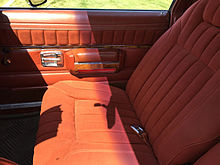This article has multiple issues. Please help improve it or discuss these issues on the talk page. (Learn how and when to remove these messages)
|


A door card (in British English) or a door panel (in American English) is an insert on the door of a vehicle that covers the door's internal components.
Design
The door card will usually match the rest of the vehicle's interior. Door panels were formerly made of cardboard with an upholstered interior finish of vinyl, leather, cloth, carpet, or other materials for the decorative trim. Modern cars typically have door cards made of plastic, most often using injection moulding, as well as incorporating other decorative materials.
The design should incorporate both the necessary service amount and the functional unit (such as "it is strong" and "it looks and feels good") so that a given car door panel "would service a car body's life span of 200,000 kilometres (124,274 mi)." The door panel typically incorporates other parts that contribute to the appearance, functionality, and ergonomics of the vehicle. These include armrests, switches or other controls for windows and the locking mechanism, convenience lights, audio speakers, storage compartments, and other features.
In most cases, the door card is attached to the car's door frame by visible screws and ones hidden behind decorative plugs or under the armrest, as well as spring clips.
See also
References
- Smitthipong, Wirasak; Chollakup, Rungsima; Nardin, Michel (2014). Bio-Based Composites for High-Performance Materials: From Strategy to Industrial Application. Taylor & Frances. p. 295. ISBN 9781482214482. Retrieved 2 February 2016.
- Corneilse, Mark (2007). Automotive repair and maintenance: level 2. Pearson Education South Africa. p. 201. ISBN 9781868917563. Retrieved 2 February 2016.
- Ramsey, Dan; Ramsey, Judy (2009). Teach Yourself Visually, Car Care & Maintenance. Wiley & Sons. p. 160. ISBN 9780470446782. Retrieved 2 February 2016.